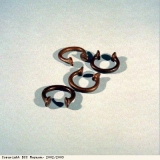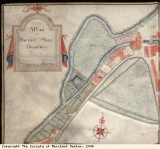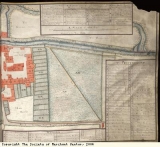Locally supplied goods: brass industry
The brass industry was an important industry in Bristol. It supplied the African slave trade as much as local needs at home in Bristol and the surrounding areas. Emanuel Swedenborg in his 1734 book on brass, de Cupro, wrote that “The principal place where English brass is made is at Baptist Mills near Bristol”.
The raw materials were easily available. Brass is made from a mixture of copper and zinc. Copper ore (rock containing copper) was imported from nearby Cornwall and North Devon, and also from America. Baptist Mills was using 200 tons a year by 1712. A form of zinc was found on the Mendip Hills, in Somerset in 1566 and Bristol’s supplies came from there. The fuel used by the brass industry to heat the furnaces was coal, which came from the local coal mines at Kingswood, near Bristol. By 1712 the Bristol Brass & Copper Company works were using 2,000 cartloads of coal a week.
The Baptist Mills brass works were started in 1702 by Abraham Darby. The plan of the works shown here gives an idea of its size, showing the large number of workshops for the different areas of brass manufacture. Nehemiah Champion took the works over from Darby in the 1720s. The company was known as the Bristol Brass & Copper Company and by various other names. The copper ore was smelted (the metal was melted out of the rock) at the nearby Crew’s Hole works, brass was made at Baptist Mills and wire and pans made at small works along the river Avon. The works closed in 1814 when all production moved to the Avon Mill at Keynsham, north east of Bristol.
William Champion formed the Warmley company in 1746. A modern steam engine was installed at the brass works in 1749. Everything was done on one site, from smelting to beating out pots and pin-making. Investors in the works included members of the Goldney and Harford families, local families with many financial and trading interests. A stocktake made in 1767 estimated that the works and stock were worth £300,000 (about £20 million today). This picture of the Black Castle at Arnos Court in Bristol shows the use of black building blocks seen in and around Bristol. They were made with waste produced from the brass industry, called slag. William Reeve, who built Arnos Court and the Black Castle, owned a brass works. Casting the slag into building blocks solved the problem of disposing of the large amounts of waste produced by the industry, and made more profit for the brassworks.
The growth of the slave trade and the development of the British brass industry were linked. Brass and copper trade goods were a very important part of the slave ship cargoes bound for Africa, because copper was highly valued in Africa. The brass manillas, as pictured here, and copper rods were used as money by the traders. Brass pots and pans and kettles were also bought by the African traders to sell on for use in the home. Brass was also melted down and used by African craftspeople to make other items.






